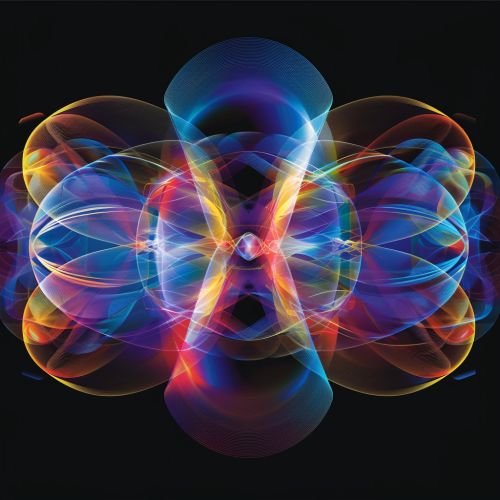Quantum Phase: Difference between revisions
(Created page with "== Introduction == A quantum phase is a fundamental concept in quantum mechanics, describing the phase of a wave function, which is a complex-valued function that encodes the probability amplitude of a quantum system's state. The phase of a wave function plays a crucial role in phenomena such as interference and entanglement, and it has profound implications for the behavior of quantum systems. == Quantum Wave Function == The wave function is a mathematical repres...") |
No edit summary |
||
| Line 59: | Line 59: | ||
The concept of quantum phase is a cornerstone of quantum mechanics, influencing a wide range of phenomena and applications. Understanding the phase of a wave function and its implications is essential for advancing our knowledge of quantum systems and developing new technologies. | The concept of quantum phase is a cornerstone of quantum mechanics, influencing a wide range of phenomena and applications. Understanding the phase of a wave function and its implications is essential for advancing our knowledge of quantum systems and developing new technologies. | ||
[[Image:Detail-92831.jpg|thumb|center|Illustration of quantum wave interference pattern.|class=only_on_mobile]] | |||
[[Image:Detail-92832.jpg|thumb|center|Illustration of quantum wave interference pattern.|class=only_on_desktop]] | |||
== See Also == | == See Also == | ||
Latest revision as of 15:24, 21 June 2024
Introduction
A quantum phase is a fundamental concept in quantum mechanics, describing the phase of a wave function, which is a complex-valued function that encodes the probability amplitude of a quantum system's state. The phase of a wave function plays a crucial role in phenomena such as interference and entanglement, and it has profound implications for the behavior of quantum systems.
Quantum Wave Function
The wave function is a mathematical representation of the quantum state of a system. It is typically denoted by the Greek letter Ψ (psi) and is a complex function of the system's coordinates and time. The wave function contains all the information about the system's state, and its square modulus gives the probability density of finding the system in a particular configuration.
The phase of the wave function is the argument of the complex number Ψ, and it can be expressed as: \[ \Psi(\mathbf{r}, t) = |\Psi(\mathbf{r}, t)| e^{i\phi(\mathbf{r}, t)} \] where \( |\Psi(\mathbf{r}, t)| \) is the amplitude and \( \phi(\mathbf{r}, t) \) is the phase.
Quantum Interference
Quantum interference is a phenomenon that arises due to the superposition principle, where the wave functions of different quantum states can add constructively or destructively. The phase difference between the wave functions determines the nature of the interference pattern. Constructive interference occurs when the phase difference is an integer multiple of \(2\pi\), while destructive interference occurs when the phase difference is an odd multiple of \(\pi\).
Berry Phase
The Berry phase is a geometric phase acquired by a quantum system's wave function when the system's parameters are varied adiabatically and cyclically. It was first discovered by physicist Michael Berry in 1984. The Berry phase is given by: \[ \gamma = \oint_C \mathbf{A} \cdot d\mathbf{R} \] where \(\mathbf{A}\) is the Berry connection and \(C\) is the closed path in parameter space.
The Berry phase has significant implications in various fields, including condensed matter physics, quantum computing, and molecular dynamics.
Aharonov-Bohm Effect
The Aharonov-Bohm effect is a quantum mechanical phenomenon in which a charged particle is affected by an electromagnetic potential, even in regions where the magnetic field is zero. This effect demonstrates the importance of the phase of the wave function in quantum mechanics. The phase shift experienced by the particle is given by: \[ \Delta \phi = \frac{e}{\hbar} \oint \mathbf{A} \cdot d\mathbf{l} \] where \(e\) is the charge of the particle, \(\hbar\) is the reduced Planck constant, and \(\mathbf{A}\) is the vector potential.
Quantum Entanglement
Quantum entanglement is a phenomenon where the quantum states of two or more particles become correlated in such a way that the state of one particle cannot be described independently of the state of the other particles. The phase relationship between the entangled particles' wave functions is crucial for maintaining the entanglement.
Entanglement has profound implications for quantum information theory and quantum computing, enabling protocols such as quantum teleportation and superdense coding.
Quantum Phase Transitions
A quantum phase transition is a transition between different quantum phases of matter at zero temperature, driven by quantum fluctuations. Unlike classical phase transitions, which are driven by thermal fluctuations, quantum phase transitions occur due to changes in parameters such as pressure, magnetic field, or chemical composition.
Quantum phase transitions are characterized by changes in the ground state of the system and are described by quantum critical points. These transitions have been observed in various systems, including superconductors, magnetic materials, and ultracold atomic gases.
Topological Phases
Topological phases of matter are phases that cannot be described by local order parameters and symmetry breaking, as in conventional phases. Instead, they are characterized by global topological invariants. Examples of topological phases include the quantum Hall effect and topological insulators.
Topological phases have robust edge states that are protected by the system's topology, leading to potential applications in fault-tolerant quantum computing.
Applications of Quantum Phase
The concept of quantum phase has numerous applications across various fields of physics and technology:
- **Quantum Computing**: Quantum phase plays a crucial role in quantum algorithms and error correction protocols.
- **Interferometry**: Devices such as Mach-Zehnder interferometers and Sagnac interferometers rely on quantum phase for precise measurements.
- **Quantum Cryptography**: Quantum phase is used in protocols like quantum key distribution to ensure secure communication.
Conclusion
The concept of quantum phase is a cornerstone of quantum mechanics, influencing a wide range of phenomena and applications. Understanding the phase of a wave function and its implications is essential for advancing our knowledge of quantum systems and developing new technologies.


See Also
- Wave Function
- Berry Phase
- Aharonov-Bohm Effect
- Quantum Entanglement
- Quantum Phase Transition
- Topological Phases
- Quantum Hall Effect
- Quantum Computing
- Mach-Zehnder Interferometer
- Sagnac Interferometer
- Quantum Key Distribution
